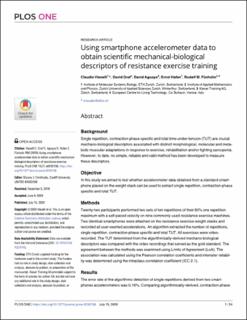Please use this identifier to cite or link to this item:
https://doi.org/10.21256/zhaw-22039| Publication type: | Article in scientific journal |
| Type of review: | Peer review (publication) |
| Title: | Using smartphone accelerometer data to obtain scientific mechanical-biological descriptors of resistance exercise training |
| Authors: | Viecelli, Claudio Graf, David Aguayo, David Hafen, Ernst Füchslin, Rudolf M. |
| et. al: | No |
| DOI: | 10.1371/journal.pone.0235156 10.21256/zhaw-22039 |
| Published in: | PLOS ONE |
| Volume(Issue): | 15 |
| Issue: | 7 |
| Page(s): | e0235156 |
| Issue Date: | 2020 |
| Publisher / Ed. Institution: | Public Library of Science |
| ISSN: | 1932-6203 |
| Language: | English |
| Subjects: | Accelerometry; Adult; Aged; Female; Healthy volunteer; Human; Male; Middle aged; Muscle contraction; Muscle, skeletal; Reproducibility of results; Weight lifting; Young adult; Resistance training; Smartphone |
| Subject (DDC): | 613: Personal health |
| Abstract: | Background Single repetition, contraction-phase specific and total time-under-tension (TUT) are crucial mechano-biological descriptors associated with distinct morphological, molecular and metabolic muscular adaptations in response to exercise, rehabilitation and/or fighting sarcopenia. However, to date, no simple, reliable and valid method has been developed to measure these descriptors. Objective In this study we aimed to test whether accelerometer data obtained from a standard smartphone placed on the weight stack can be used to extract single repetition, contraction-phase specific and total TUT. Methods Twenty-two participants performed two sets of ten repetitions of their 60% one repetition maximum with a self-paced velocity on nine commonly used resistance exercise machines. Two identical smartphones were attached on the resistance exercise weight stacks and recorded all user-exerted accelerations. An algorithm extracted the number of repetitions, single repetition, contraction-phase specific and total TUT. All exercises were video-recorded. The TUT determined from the algorithmically-derived mechano-biological descriptors was compared with the video recordings that served as the gold standard. The agreement between the methods was examined using Limits of Agreement (LoA). The association was calculated using the Pearson correlation coefficients and interrater reliability was determined using the intraclass correlation coefficient (ICC 2.1). Results The error rate of the algorithmic detection of single repetitions derived from two smartphones accelerometers was 0.16%. Comparing algorithmically-derived, contraction-phase specific TUT against video, showed a high degree of correlation (r>0.93) for all exercise machines. Agreement between the two methods was high on all exercise machines as follows: LoA ranged from -0.3 to 0.3 seconds for single repetition TUT (0.1% of mean TUT), from -0.6 to 0.3 seconds for concentric contraction TUT (7.1% of mean TUT), from -0.3 to 0.5 seconds for eccentric contraction TUT (4.1% of mean TUT) and from -1.9 to 1.1 seconds for total TUT (0.5% of mean TUT). Interrater reliability for single repetition, contraction-phase specific TUT was high (ICC > 0.99). Conclusion Data from smartphone accelerometer derived resistance exercise can be used to validly and reliably extract crucial mechano-biological descriptors. Moreover, the presented multi-analytical algorithmic approach enables researchers and clinicians to reliably and validly report missing mechano-biological descriptors. |
| URI: | https://digitalcollection.zhaw.ch/handle/11475/22039 |
| Fulltext version: | Published version |
| License (according to publishing contract): | CC BY 4.0: Attribution 4.0 International |
| Departement: | School of Engineering |
| Organisational Unit: | Institute of Applied Mathematics and Physics (IAMP) |
| Appears in collections: | Publikationen School of Engineering |
Files in This Item:
| File | Description | Size | Format | |
|---|---|---|---|---|
| 2020_Viecelli-etal_Smartphone-accelerometer-data.pdf | 4.45 MB | Adobe PDF |  View/Open |
Show full item record
Viecelli, C., Graf, D., Aguayo, D., Hafen, E., & Füchslin, R. M. (2020). Using smartphone accelerometer data to obtain scientific mechanical-biological descriptors of resistance exercise training. Plos One, 15(7), e0235156. https://doi.org/10.1371/journal.pone.0235156
Viecelli, C. et al. (2020) ‘Using smartphone accelerometer data to obtain scientific mechanical-biological descriptors of resistance exercise training’, PLOS ONE, 15(7), p. e0235156. Available at: https://doi.org/10.1371/journal.pone.0235156.
C. Viecelli, D. Graf, D. Aguayo, E. Hafen, and R. M. Füchslin, “Using smartphone accelerometer data to obtain scientific mechanical-biological descriptors of resistance exercise training,” PLOS ONE, vol. 15, no. 7, p. e0235156, 2020, doi: 10.1371/journal.pone.0235156.
VIECELLI, Claudio, David GRAF, David AGUAYO, Ernst HAFEN und Rudolf M. FÜCHSLIN, 2020. Using smartphone accelerometer data to obtain scientific mechanical-biological descriptors of resistance exercise training. PLOS ONE. 2020. Bd. 15, Nr. 7, S. e0235156. DOI 10.1371/journal.pone.0235156
Viecelli, Claudio, David Graf, David Aguayo, Ernst Hafen, and Rudolf M. Füchslin. 2020. “Using Smartphone Accelerometer Data to Obtain Scientific Mechanical-Biological Descriptors of Resistance Exercise Training.” Plos One 15 (7): e0235156. https://doi.org/10.1371/journal.pone.0235156.
Viecelli, Claudio, et al. “Using Smartphone Accelerometer Data to Obtain Scientific Mechanical-Biological Descriptors of Resistance Exercise Training.” Plos One, vol. 15, no. 7, 2020, p. e0235156, https://doi.org/10.1371/journal.pone.0235156.
Items in DSpace are protected by copyright, with all rights reserved, unless otherwise indicated.